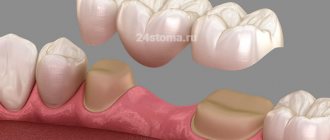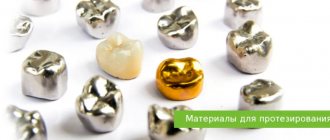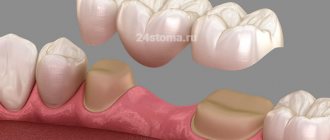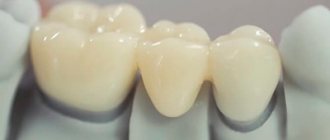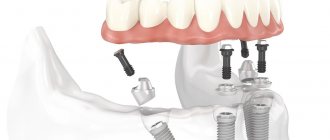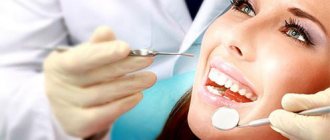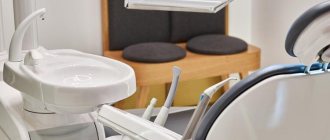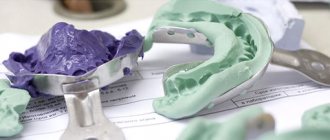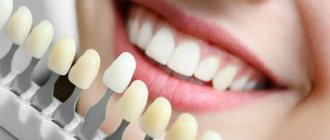About guarantees What affects the cost?
What do clinics save on? Importance of diagnostics Qualification of doctors What to pay attention to? Dental implantation has become a part of modern life, but most people are wary of this operation. Expensive and time consuming - these are the main associations. But this is no longer the case at all.
An implant is a titanium pin (rod) that is screwed into the gum. There it is overgrown with bone tissue and serves as a solid basis for the crown. Why is it better to get an implant?
Bridges and dentures on implants are held firmly and do not irritate the mucous membrane. They prevent the loss of bone tissue, which means the smile remains young and the jaw does not collapse. In addition, caring for implants is not burdensome; it is no different from caring for natural teeth.
What prostheses can be placed in the smile zone - the most complete list of solutions and their features
Article navigation
- Indications for prosthetics
- Important Features
- Prosthetic options
- Removable prosthetics
- Fixed dentures
- Implantation of incisors and canines
- Which dentures are better?
- Which material to choose
- In what situations is enamel grinding not necessary?
- Periodontitis and periodontal disease
- Contraindications
- Dentists' recommendations
- Price
Question for a specialist
People practically do not use incisors for chewing food, which is why when restoring them, high demands are placed mainly only on aesthetics and restoration of the correct bite. It is very important that your smile looks natural and natural. However, the material must still be strong enough to withstand the average load of biting food. Because of all these features, prosthetics of the front teeth contains many nuances, which will be discussed further.
Why then is compulsory medical insurance so cheap?
Because compulsory medical insurance does not have the task of preserving the patient’s teeth, making them aesthetically pleasing and comfortable. The basic paradigm of compulsory medical insurance is to preserve the life and working capacity of a person by finding such a balance between the under-produced citizen of GDP and the cost of intervention so that an optimal economy is obtained. To prevent deaths from complications of caries, teeth were simply pulled out. And for quite a long time - without anesthesia. It was only in 1980 that a decree was issued that tooth extraction must be performed using anesthesia in every case. Before this, pain relief was done as needed. My grandfather told me that there was a hut on Dzerzhinsky Square. There was a grandmother who, for a ruble, would pour a glass of vodka and remove a tooth. He deleted it there too.
Indications for prosthetics in the smile area
When thinking about prosthetics for the upper or lower front teeth, you need to know in what cases it is necessary. It is clear that the complete absence of an incisor or canine tooth along with the root is a direct indication for prosthetics. But there are other cases when it is a prosthesis in the classical sense that is needed, and not a filling. Let's look at the main indications for prosthetics in the smile area:
- chipped crown: the defect is more than half of its original size,
- cracks in the enamel or its abrasion,
- malocclusion: only in case of minor pathologies it is corrected with dentures, otherwise braces/aligners (orthodontic aligners) are needed,
- frequent caries under fillings,
- enamel defects: darkening, smoker’s plaque, “tetracycline” staining, fluorosis, thin enamel layer,
- complete absence of a tooth along with the root.
That is, prosthetics are necessary to recreate the aesthetics and functionality of a smile, as well as to create a more attractive appearance. The latter is especially true for public people and women.
Rating of products in terms of price-quality ratio
It often becomes obvious that the lower the prices, the more this affects the quality. However, there are exceptions. The quality of the implant is the key to maintaining health. Otherwise, there is a risk of developing complications, the main one of which is rejection of the structure.
Let's move on to the rating:
- The first place is occupied by premium class implants: Nobel Biocare, Straumann, Astra Tech with a lifetime guarantee. Companies train specialists to work with these dental systems.
- In second place in the ranking are designs created with financial support from the German government (Xive Friadent, Ankylos). High quality and relatively low price are the main advantages.
- Third place is given to American models in the mid-price segment - BioHorizons, Biomed, Bicon. They are securely fixed and take root quickly.
- Fourth are budget implants from Israeli and South Korean manufacturers: AlphaBio, MIS, Implantium, Ards. They are in high demand due to their low prices. The quality is up to par. The survival rate of such models is 95-98%.
Implantologist's opinion : “I recommend Astra implants to my patients. Once installed, they correctly distribute the load on the jawbone, which helps prevent atrophy. The last point is very important."
Important features of restoration of incisors and canines
Features of prosthetics of the anterior teeth of the lower and upper jaw are as follows:
- it is important to recreate the aesthetics of the smile and face: choose the right shape and color of dentures that are identical to the enamel of neighboring units of the dentition,
- it is important to pay attention to the position of the gums: the contour of the mucous membrane should be natural and natural,
- it is important to ensure good fixation of the prosthesis: so that a person can not only smile, but also bite and chew food normally (although biting off very hard foods will no longer be possible in any case),
- It is important that the restoration does not cause discomfort and does not provoke pathologies: allergies or inflammation.
South Korean implant Osstem - 20,000 rub.
Hurry up to sign up for a free consultation and lock in promotional prices.
Call now or request a call
Opening hours: 24 hours a day - seven days a week
Technical base
Another criterion when choosing where to install dental implants is the presence of its own technical laboratory. The implant is in the gum, no one sees it, but the crown or artificial jaw is in plain sight. It is important not only to ensure high functional properties of the prosthesis, but also its aesthetic appearance. Third-party technicians will never put in as much effort, select a shade, or grind out small details as much as those who work in the center.
Installing dental implants is the job of the doctor, prosthetics is the responsibility of the technician.
Removable prosthetics and its features
- When to use: if one or more front teeth are missing along with the roots, that is, they are completely removed.
The peculiarity of removable dentures is that they are fixed to the supporting teeth with hooks (clasps). These clasps are noticeable when you smile (if the hooks are made of metal) or often become loose and break (if the clasps are made of plastic). The attachments can damage the enamel of the supports or the surrounding gums, causing inflammation. By the way, this can also include a rapid decline in aesthetics, because plastic teeth quickly darken from plaque, and it will not be possible to whiten them to an ideal state.
Most often, a removable butterfly prosthesis is placed on the front teeth (if the chewing ones are preserved) - and only as a temporary solution. In other cases, in order to also partially restore the chewing teeth, you will have to make a massive prosthesis with a voluminous plastic palate or gum - this way it will hold better, but with less comfort.
In orthopedic dentistry, there are the following types of removable dentures:
- acrylic: made of long-known and inexpensive acrylic plastic,
- Acry-free (“Acry-free”): a modern variation of the previous type. Made from plastic that contains virtually no acrylic monomer (somewhat a toxic substance found in conventional acrylics),
- polyurethane: Russian alternative to nylon structures. The material is soft and flexible,
- clasp: unlike all the others, clasps have a metal arch, which adds rigidity and more correctly distributes the chewing load. The upper palate is not made solid, but in the form of a small bridge, which increases wearing comfort. Clasp ones will be placed only if at least part of the lateral teeth is missing, otherwise they simply cannot be fixed,
- Quattro Ti (“Quadrotti”): similar to clasp ones in structure and scope, but “Quadrotti” do not have a metal arc. They are made only from Dental D material (a combination of nylon and plastic), patented by Quattro Ti.
To read about each individual type of prosthesis, click on the name to go to the corresponding page with a description.
Brands and quality of inexpensive dental implants
We should start with the fact that high-quality implants cannot be cheap. About 30-50% of the cost of the entire treatment falls on titanium structures. Their cost consists of the brand, prices for materials, equipment and technologies that are used in the process of their creation. It's possible that dental implants will actually become cheaper over time, but don't count on this happening any time soon. The technological solutions that are necessary for the manufacture of truly high-quality titanium products with maximum survival and safety indicators are expensive, and it is this factor that largely determines such a high price for the final product.
Less expensive models have the same high survival rates and excellent performance characteristics
However, today implantologists around the world actively use in their practice inexpensive systems that are available to a wider range of consumers. They often demonstrate equally high survival rates and excellent performance characteristics, which makes them virtually comparable to premium brand products. Popular budget brands that produce high-quality designs are presented in the table below.
| Brand | Comments | Approximate prices – 1 implant without crown |
| MIS (Israel) | The Israeli brand has a sufficient number of clinical studies confirming the quality of its products. However, under this brand there are models suitable only for delayed loading. Implants are made of titanium alloy (may cause allergies). The downside is that the manufacturer does not provide a very big guarantee. | 20-25 thousand rubles |
| Alpha BIO (Israel) | Another inexpensive Israeli brand that, unlike its predecessor, offers a lifetime warranty. The models are designed for delayed loading, although some specialists use them for complex prosthetics on 4-6 artificial roots with immediate loading. Since there is no confirmed clinical data on the effectiveness of such treatment, such a decision can be quite risky. Titanium alloy is used to create Alpha BIO implants. | 20-25 thousand rubles (complete denture for 1 jaw with 4 screws: 130-150 thousand rubles) |
| BioHorizons (USA) | A brand with a 20-year history produces mainly models for delayed loading, but in some cases they can be installed as part of comprehensive solutions with early fixation of the prosthesis. The company also introduced the TeethXpress protocol - restoration of a full jaw with 4 or 6 artificial roots. However, in Russia this solution is practically not used. | 40-45 thousand rubles |
| Osstem (South Korea) | Budget analogues of products from the premium brand Nobel Biocare. The range includes models for both immediate loading and the classic two-stage protocol. Products produced under this brand demonstrate fairly high quality indicators. The implants are based on a titanium alloy. | 30 thousand rubles (complete denture for 1 jaw with 4 screws: 180-200 thousand rubles) |
| Oneway Biomed (Switzerland) | Brand of the Swiss manufacturer Ihde Dental. The range includes mainly one-piece models for immediate loading - a suitable choice for complex restoration of the jaw in conditions of severe atrophy and inflammatory processes. It is based on Grade4 titanium. The implants themselves are implanted into deeper and less porous parts of the jaw bone, which ensures their high primary stabilization. | 35 thousand rubles with immediate loading with a crown (complete denture for 1 jaw with 8-12 screws: 250-300 thousand rubles) |
Fixed dentures to restore the smile area
- When to use: if teeth have lost their aesthetics, are partially destroyed, there are chips - these are indications for installing veneers or crowns. If the teeth are missing along with the roots, then bridges are placed.
Fixed ones correspond to almost all features of prosthetics, since they are highly aesthetic, are well fixed, and the absence of plastic gums and palate makes wearing them quite comfortable. But all this provided that an experienced orthopedist was involved in the prosthetics, high-quality materials and technological equipment were used.
%akc72%
The advantage of non-removable ones is that they last much longer than removable ones. Fixed ones do not move, they do not need to be taken out of the mouth to clean (and the person will not forget to put them back), they do not need to be glued to the cream, and there is no need to get used to a foreign object in the mouth. The disadvantages include the cost, which is significantly higher than that of removable ones.
Aesthetic prosthetics – veneers, lumineers, ultraneers
Veneers, lumineers and ultraneers are durable and aesthetic microprostheses for the smile area; they are installed only on the front part of the dentition and mask minor defects, creating a “Hollywood smile”. They can cover cracks in the enamel, small chips, interdental spaces (diastemas and trema), and slightly level the inclination of the teeth.
Veneers (in fact, lumineers and ultraneers are also veneers) are presented in the form of thin ceramic overlays. Their thickness varies between 0.3-0.6 mm. And if ultraneers are just thin veneers (0.3 mm), then lumineers are already a patented brand with its own manufacturing technology (the thickness of lumineers is about 0.2 mm). You can evaluate the aesthetics of lumineers restoration using photos before and after prosthetics of the front teeth.
Among the positive aspects of veneers are the highest aesthetics and durability (10-20 years of trouble-free wear). The disadvantages include very careful operation of the restoration, high cost, and the need to install 6-8 veneers or lumineers per row at once. But in the case of classic veneers, it is possible to replace one or two front teeth.
Traditional prosthetics with crowns
If the top is destroyed by more than half, but the roots are intact, it is recommended to use dental crowns.
A crown is a cap-shaped prosthesis that restores a single defect and is placed on some kind of support. It perfectly follows the shape of the natural tooth apex and is fixed very firmly with special cement. But it is rarely possible to remove a crown without damaging it, for example, to treat root canals or periodontitis. In this case, you have to make a new one. And after several removals/fixations, a situation often arises that the root has to be removed (if it is severely damaged due to caries or frequent treatment). Then it is no longer possible to install a crown; you have to look for other prosthetic options.
To fix the crowns, a certain support is required:
- the preserved part of the natural tooth apex: it is previously ground down to give the shape of a stump or a truncated cone,
- post: a metal screw that is secured into the tooth root. The advantages of the method are low price, the disadvantages are uneven load on the root, insufficient fastening reliability,
- stump tab: a more successful (but also expensive) analogue to a pin. The inlay can be made of durable metal-free materials, the shape exactly follows the cavity inside the root and rises above the gum so that the crown can be fixed to it. Metal-free materials transmit light in a similar way to natural tooth enamel. This option looks more aesthetically pleasing and will last many times longer than pins.
Bridges
They are used when 1-4 teeth are missing in a row. A necessary condition is the presence of supports (or their healthy roots) along the edges of the defect.
Bridges (or bridges) are several crowns connected in a row. Bridges differ from single crowns in that they do not have holes at the bottom and rest on the gums, and the outer ones are created for fixation on supports. Also, “wings” – located along the edges of the bridge – can be attached to these supports.
Adhesive bridges1 have just such “wings”. These bridges are temporary, but are fixed quite reliably (they can come off due to chewing gum or very hard food). The installation can be performed on children and adults - on a temporary basis while awaiting implantation, for example.
The advantages of bridges include high aesthetics, long-term fixation and comfortable operation. But they have a very big drawback - the need to grind down the supports and remove their “dental nerves”. These factors, plus additional chewing load, lead to rapid failure of the supports. You have to re-treat them, and eventually remove them - and each time you need to redo the bridges or make new ones. As a result, when the defect becomes very extensive, you will have to completely abandon bridges in favor of other types of prosthetics.
Another significant disadvantage is that when wearing bridges (as well as removable structures), the bone will constantly atrophy under the plastic base or “empty” crowns. Along with the bone, the gums also recede, making the smile unattractive and allowing food to accumulate in the space between the denture and the gums. After every few months of wearing it, you have to go to an orthopedist and adjust the displaced prosthesis.
Which implants are more expensive, but better?
As has been mentioned many times above, implantation is the best option to restore your smile. But at the same time, this is a responsible undertaking in which every aspect is of great importance. Remember that not only beauty is at stake, but also health. Therefore, implants should still be chosen based primarily on indicators of quality, reliability and safety, and not just from the point of view of economy.
Premium implant systems have impeccable reliability characteristics and high survival rates
The table below presents the leading brands that produce premium implant systems with impeccable reliability characteristics and high survival rates, which is confirmed by the results of many years of clinical studies. You can really trust these manufacturers.
| Brand | Comments | Approximate prices – 1 implant without crown |
| Nobel Biocare (USA-Switzerland) | The undisputed leader in the production of modern high-quality implantological systems and the development of advanced treatment protocols, incl. all-on-4 and all-on-3. The product range of a company with more than half a century of history also includes Zygoma zygomatic models for the upper jaw. In its production, the company actively uses patented high-tech solutions that allow it to create premium quality products. Implants are made from pure Grade4 titanium, and their survival rate in bone reaches a record 97.1-99.2%. An important advantage of Nobel Biocare is the presence of an impressive clinical base confirming the effectiveness and safety of their products in the long term. | 40-50 thousand rubles (complete denture for 1 jaw with 4 screws using the all-on-4 system: from 280 thousand rubles) |
| Straumann (Switzerland) | Another leading manufacturer whose products receive praise from specialists and their patients around the world. The range includes models for a wide variety of clinical cases. The company has been on the market for over 40 years and also boasts clinically proven quality of its products for decades to come. As in the case of Nobel Biocare, Swiss-made structures are created from pure Grade4 titanium, which significantly increases their osseointegration rates (97-99%) and virtually eliminates the risk of rejection. The line also includes all-ceramic models and modifications made of titanium with zirconium dioxide (Roxolid). | 40-50 thousand rubles (complete denture for 1 jaw with 4-6 screws: 400-500 thousand rubles) |
| Astra Tech (Sweden) | The premium brand produces high-quality implants with excellent strength and reliability characteristics. On average, the survival rate varies from 94-100%. Wide selection of models for almost any clinical case. | 50-60 thousand rubles |
Implantation of incisors and canines – installation of 1 crown and bridge on implants
- When to use: in the absence of any number of teeth on any of the jaws. These may be single or isolated defects; an entire segment or all teeth may be missing at once. You can even place an implant in the hole of a recently removed tooth root.
An implant is an artificial metal root that is fixed in the bone tissue if there is no tooth root in it. When restoring anterior teeth, it is recommended to install a white aesthetic abutment made of zirconium dioxide. It also corrects the position of the gums, which allows you to achieve ideal aesthetics.
Today, the most ideal method of prosthetics in dentistry is dental implantation. It is suitable for any area of the dentition, with any number of defects - from single and scattered to complete edentia. The most significant advantages of implantation look like this:
- no need to grind down adjacent teeth,
- the highest possible aesthetics – crowns on implants are completely indistinguishable from natural teeth,
- very strong fixation of the implant in the bone and the crown on the implant itself,
- ability to withstand good loads: but the frontal zone should not be overloaded,
- materials for implantation are biocompatible with the body,
- implant-supported dentures have the highest wearing comfort,
- the service life of the implant is eternal, and the prosthesis on it will last at least 15-25 years,
- implants help rebuild the bone around them, maintaining gum level.
Crowns or bridges are placed on top of the implants, as well as bridges with small inclusions of artificial gum (to mask the uneven contour of the natural gum).
Implantologists
Most importantly, make sure that the implantologist is not a visiting specialist, but is part of the clinic’s staff. If a doctor is here today and there tomorrow, it will be difficult for you to get an appointment, and simply track his movements from clinic to clinic. In addition, visiting consultants are little concerned about the prestige of the dental center; they do not have close connections with doctors from other departments and technicians.
Education also plays a role. Not only the basic ones received many years ago, but constantly updated. Is the doctor certified to work with a specific brand? How long has it been since she took courses and attended trainings? Implantology is akin to programming - you get distracted for a while and that’s it, you can’t catch up. Simply placing a dental implant is not enough these days; you need to use current techniques with a high percentage of engraftment.
To summarize: which prostheses are better?
Which prosthesis is better to choose for prosthetics of front teeth? Let's summarize all the information already available and determine the optimal solution.
| Problem | The best decision |
| If 1 tooth is missing with a root | The crown on the implant will last from 15 years, and the service life of the implant is decades |
| If several teeth are missing | A segment or several crowns, again installed on implants |
| If the top is chipped | If the chip is small - less than 30% of your own enamel, then a veneer is placed. If most of it is missing, a crown on a pin or stump tab |
| If the top is destroyed | If the roots are healthy and intact, then a crown is placed on the stump tab. If the roots are destroyed, they are removed and an implant is placed. |
Licenses and certificates
A clinic where an implant can be installed must have a license for this type of activity. Certificates confirming partnerships with supplier companies protect against counterfeiting. Doctors are awarded certificates upon completion of training on working with a specific brand. Typically, dental centers are proud of their achievements and display documents for public viewing. If certificates and licenses are not visible, something is wrong with the clinic.
What material to choose for dentures in the smile area
- plastic and metal-plastic: the most affordable option, but has poor aesthetics and a short service life, therefore it is used only as a temporary solution,
- metal ceramics: a durable and inexpensive option, but not aesthetically pleasing enough for the smile area. In addition, if the metal comes into contact with the gum, it will turn blue over time - this will be noticeable,
- solid ceramics: looks as natural as possible and is quite durable, especially provided that in the frontal area the load on the teeth is minimal,
- Zirconium dioxide or aluminum oxide: the most preferred option, natural, strong and durable. But also the most expensive.
When is metal ceramics used?
Metal-ceramic crowns are one of the most popular options in orthopedic dentistry. It is used quite often because it has an affordable price, high strength and aesthetics. However, they are best used to restore the masticatory sections, but not the anterior ones.
The disadvantages of metal ceramics are as follows:
- may cause allergies: in this case, the cobalt-chromium alloy can be replaced with gold, but the cost of treatment will increase significantly,
- when metal and gums come into contact, “cyanosis” of the mucous membrane may occur,
- your own tooth enamel must be sharpened,
- Mandatory nerve removal is required, even if the root canals are healthy.
When to use ceramics
A more preferable option for the frontal zone. Moreover, modern ceramics have become stronger and more durable. Such dentures are distinguished by natural translucency, the ability to select the shade of ceramics in full accordance with the color of natural enamel. They do not cause blue gums and require minimal grinding of the own enamel, while the dental nerve (if indicated) can be preserved. The only drawback is that they are higher in price than metal-ceramic ones. In addition, it is not advisable to fix them on implants or pins - a metal base can lead to splitting of the structure. Solid ceramics are attached only to your own tooth or core inlay.
When is zirconium dioxide used?
Zirconium dioxide or aluminum oxide are durable materials that are processed using modern computerized equipment. CAD/CAM technology is used to create a customized prosthesis, as well as scanning the entire oral cavity and modeling structures in a computer program. This allows you to achieve incredible precision at all stages of prosthetics. Among the main advantages are the longest service life (from 15-20 years), incredible aesthetics of both the restoration itself and the gum area, the absence of allergic reactions and minimal grinding of the enamel.
Not only crowns and bridges, but also veneers can be made from ceramics and zirconium dioxide.
Don't know what type of prosthetics to choose?
We will help in the selection, advise where to read more information and compare types of prosthetics.
Consultation with an orthopedic doctor in Moscow clinics is free! Call now or request a call
Working hours: from 9:00 to 21:00 - seven days a week
How do dental centers save?
Clinics for which reputation is less important than immediate income save on us, the patients. They do this using different tricks.
Sterility
When we go to the dentist, we assume that everything around us is sterile, the surfaces have been treated, and the instruments have just come out of the autoclave. As for the tools, this is usually the case, but everything else! We almost added some antiseptic, wiped the surfaces not 4 times, but 2 times, you see, and saved a pretty penny. Yes, and the processing of instruments can be normal, or it can be carried out according to the “Anti-AIDS”, “Anti-Hepatitis” system..
Sterilization in ROOTT clinics using the “Anti-AIDS” and “Anti-hepatitis” systems
Antiseptics
According to the rules, the type of antiseptic must be changed every six months. This is where social responsibility comes into play. Some centers do this even more often, while others don’t bother at all. The main thing is that it’s cheap, and if the flora becomes resistant, it will probably carry through. It is almost impossible to prove the fact of infection in dentistry.
Tools
Responsible clinics use disposable instruments wherever possible. Reusable ones undergo double disinfection. But the irresponsible ones try to save on both. They are much more likely to become infected. For implantation, sterility is especially important. The slightest infection can nullify the doctor’s efforts. It's good if there is a guarantee for the work. Only in such centers it is usually absent.
Materials
Once in dentistry, where they work with dozens of brands, it is difficult to be sure that cheaper materials, and even instruments, are not used in more expensive systems. High-end clinics prefer selected brands and certainly will not use Chinese materials when working with Swiss implants. Global manufacturers supply them in sets. Everything is provided there - tools, materials. Everything is verified and confirmed by certificates of conformity. Relationships with the brand are long-term; no one will risk them because of imaginary benefits.
In what situations is enamel grinding not necessary?
How is prosthetics performed in the frontal area? First, the oral cavity is prepared - caries is treated, tartar and plaque are removed, and if necessary, diseased roots are removed. Then, if you need to place a crown, bridge or veneers, you first need to grind down the supports. After this, impressions are taken (you can also perform a 3D scan of the oral cavity), which are sent to the laboratory. But turning can be avoided if the following restoration options are chosen - lumineers, clasp on hooks, immediate or removable dentures.
How to install dental bridges
If you had to remove a tooth, then after the hole has healed, it is recommended to install a bridge. There may be several stages. When manufacturing metal-ceramics, it will be necessary to turn the supports, take an impression, make the structure, try on and adjust.
If you choose ceramics or zirconium, then thanks to CEREC technology an impeccable model is immediately created, taking into account all the nuances. Come for a consultation, and together we will consider all the options for restoring your dentition, choosing a rational method and maintaining your quality of life.
Periodontitis and periodontal disease - is it possible to get dentures with such a diagnosis?
If you have periodontitis and periodontal disease, there are not many options for restoring your smile. For example, it could be a splinting “clasp” that will fix loose teeth, but will not cure periodontitis or periodontal disease. Therefore, these pathologies will have to be treated regularly, although they never go away 100%, especially in the later stages.
The ideal option again is implantation, because... implants are not natural roots on which plaque would accumulate, leading to the progression of periodontitis. Implants even promote the regeneration of your own bone and, accordingly, increase the level of gums. But here it is important to understand that it is often impossible to do without removing the remaining diseased teeth or their roots, because they are the source of infection.
How long will titanium roots last?
There are several key factors that affect the longevity of artificial roots. Here are the main ones:
- brand of implants and, accordingly, their quality, cost of materials used and technologies for their production,
- level of professionalism of the implant surgeon and orthopedist,
- the chosen treatment method (protocol),
- quality of prosthetics and accuracy of installation of orthopedic products,
- quality of preparation, diagnosis and planning,
- compliance with hygiene and doctor’s recommendations by the patient after surgery,
- the initial state of the patient’s bone tissue and the general state of his health.
Leading implant manufacturers offer a lifetime warranty on their products, but they cannot be held responsible for the quality of its installation and operation. Therefore, the clinic provides an additional guarantee for the work of its specialists.
“At one time I was given Alpha Bio, ordinary inexpensive implants. They've been standing like a glove for about 20 years now, no problems at all! True, it was diagnosed by a very good specialist, the head doctor of the clinic where my whole family and all my relatives have their teeth treated. Moreover, he installed implants for many of my friends, and no one had any problems. Just go regularly, check that everything is fine, that’s all.” Vadim_K.D., from correspondence on the 32top.ru forum
Leading implant manufacturers offer a lifetime warranty on their products
Today, specialists install implants with the expectation that they will serve the patient for the rest of his life. However, it is necessary to distinguish between the shelf life of titanium roots and prostheses attached to them. For example, on average, the service life of good quality crowns varies from 10-15 to 20 years or more, depending on the material. At the same time, the failure of a prosthetic device is not yet a reason to change the implant along with it. In most cases, you can simply replace the crown or prosthesis, but here, of course, it all depends on the situation.
Contraindications for prosthetics
All existing contraindications relate for the most part to fixed prosthetics. Moreover, there are many relative contraindications – those that can be “bypassed” over time. For example, relative prohibitions on the installation of fixed bridges or crowns, as well as implants, are imposed on the following groups of patients:
- children under 18 years of age, pregnant women: this is due to the characteristics of bone tissue and the ban on certain anesthetics,
- for diseases of the oral cavity: caries, pulpitis, stomatitis - first you need to be cured,
- for periodontitis and periodontal disease: with classic removable and fixed prosthetics, as well as with two-stage implantation. BUT! When implanted using one-stage protocols - for example, with basal implantation or all-on-6, these pathologies are not considered a contraindication.
There is, perhaps, only one absolute contraindication for removable orthopedic structures, which, by the way, also applies to non-removable ones - these are very serious mental disorders. Also, absolute contraindications, but for implantation, include the following:
- decompensated diabetes mellitus,
- serious pathologies of the heart and blood vessels, endocrine system,
- malignant diseases in the acute stage,
- tuberculosis, HIV,
- inability to carry out high-quality oral hygiene.
Diagnostics
During implantation, even the smallest details are important, so the availability of modern diagnostic equipment is an indispensable condition when choosing a clinic. It is unlikely that anyone would want to go somewhere to get a tomography or panoramic photo. Own equipment not only saves patients time, it allows doctors to use it constantly, get used to it and know what to expect. A well-equipped clinic must have an X-ray machine, both regular and for panoramic images. Tomography helps assess the volume of bone tissue, a panoramic image gives a complete picture of the structure of the jaw, and a targeted image determines how best to install the implant. One of the criteria for choosing where to do dental implantation should be the availability of modern diagnostic equipment.
Computed tomography and 3D planning of future surgery
Recommendations from dentists when choosing a prosthesis
When restoring small defects, chips and darkening, it is better to choose thin ceramic veneers or lumineers - they will make your smile beautiful for 15 years or more.
Removable orthopedic solutions in the smile area often lose their fixation, move, provoke allergies and cause difficulty chewing medium-hard food. Therefore, it is recommended to install them only as a temporary option: while the patient waits for the installation of a permanent fixed prosthesis or implant. Here, a defect in a row or a ground stump is masked with a plaster or bridge so that the smile retains its attractive appearance. Biting food with these restorations is not recommended. On an ongoing basis only if there are contraindications to fixed solutions or implantation, as well as financial limitations.
Fixed options for restoring minor dental defects, such as crowns and bridges, are quite popular due to their availability. If the natural crown is destroyed by more than half, then a worthy option is a ceramic or zirconium dioxide crown coated with ceramics. But in the case of a bridge, the patient is not immune from bone atrophy and gum loss under the prosthesis, as well as from overloading the supports.
Therefore, the optimal method for restoring the frontal zone will be implantation, because implants prevent the bone from further atrophying and maintain the aesthetics of your smile for several decades.
By the way, positive reviews from 90% of patients who underwent implantation speak of the highest comfort of life even 10-15 years after prosthetics. While 60% of people who have had classic removable prosthetics or bridges subsequently regret their decision.
Where can I insert it cheaper?
The cost of implantation, in addition to the quality of the implant itself, is affected by:
- clinic class;
- region;
- technical equipment;
- complexity of work;
- the amount of materials needed.
Among Moscow clinics, many offer economy class services. The cost of implantation in them starts from 20,000 rubles. Promotions are held periodically to help you save even more. The procedure will be cheaper in the Moscow region due to the lower cost of renting premises.
The first consultation plays a decisive role for the patient. Based on how the meeting goes, a lot will become clear. Professional institutions recommend that you first undergo an examination and consult with several doctors (surgeon, prosthetist, implantologist), and then make a decision.
The cost of restoring the smile area
How much does front tooth replacement cost? It all depends on the type of prosthesis, its design, complexity of manufacturing and installation, as well as on the materials and rating of the clinic. For example, restoration of a single defect with a composite veneer costs from 7,000 rubles, with a ceramic veneer – from 15 thousand, and one lumineer costs from 50 thousand.
Prices for metal-ceramic crowns start from 6,500 rubles, for ceramic ones – from 18 thousand, and zirconium dioxide – from 25 thousand. The cost of the bridge is calculated according to the number of crowns. A butterfly prosthesis costs from 12 thousand, a plate prosthesis can be ordered for 15-20 thousand, and clasp prostheses, Acri-free and Quadrotti cost from 35-40 thousand rubles. Installation of 1 implant on a turnkey basis, i.e. together with the crown, it will cost at least 35-40 thousand rubles - this is the most budget option, and premium brands cost 2-3 times more.
- Ervandyan A. G. Clinical and laboratory justification for the use of adhesive bridges made of ormokers and fiber materials: Dis. Ph.D. honey. Sci. Moscow, 2005. - 140 p.
What determines the price of implantation?
When determining the price of implantation, the following are taken into account:
- Materials used in production (titanium is recognized as the best).
- The surface of the product (to accelerate osseointegration, it is subjected to special treatment, crystals of hydroxyapatite or phosphates are applied, which affects the cost).
- Design dimensions.
- Shape (conical models take root faster and ensure proper distribution of the chewing load on the jaw).
- Type of thread (often 2-3 types of thread are used, according to the bone density in different areas).
- The type of connection with the abutment (for most implants this place is the most fragile, which leads to fractures and loosening of the abutment, and higher quality models have a reliable triangular connection).
- Implant rating.
- An important factor is the reputation of the manufacturer. Impeccable from European and American companies.
- The cost of installing an implant is also affected by the status of the clinic and the qualifications of the specialist.
And the doctor bears criminal liability for his decisions and actions.
When we started the clinic, we essentially wanted to do applied science, which, as it turned out, pays well.
But it is very difficult to do science if there is a chance to simply sit down. Yes, in dentistry it is difficult to cause moderate or severe harm to a patient’s health, but nevertheless, as you may know from the media, this happens. In Russia, no matter what papers you sign before the operation, the doctor is still responsible for the result of the intervention. And if the case goes to court, the court usually takes the patient’s side. This doesn't mean what you think it means. This means that a sane doctor simply does not take on difficult cases - this is especially noticeable in surgery and among our cardiologist colleagues, for example. Is there a risk? It’s a shame, but you should go to another clinic, where the doctor will take this risk upon himself. The doctor has a good portfolio, good statistics (if they are kept) - and he doesn’t really want to risk both his responsibility and just statistics, trying to save the patient. To me, this is not how medicine should work. In statistics on suicide, alcoholism, drug addiction and clinical depression, plus broken families, dentists have been breaking records for quite some time. Moreover, they often even surpass doctors of other specialties. This is partly due to the fact that it is the dentist who causes the patient the maximum discomfort, and patients often take revenge (unconsciously). That is, the doctor is the target of a negative reaction. The dentist is experiencing serious rejection.
The dentist also works with conscious patients. A dentist hesitates between providing medical care and providing a service that is assessed not by another colleague, not by a professional community, but by your patient who can say: “This is how it is for me, this is my view of it.”
Believe me, we would be much calmer if the patients lay quietly unconscious, and did not try to direct our actions. Or at least if you didn’t have to explain every manipulation. Yes, this is part of professional training, yes, assistants are very helpful. But still.
The next factor why dentists are not very popular is that with almost every doctor - from a gastroenterologist to an orthopedist - the patient solves a conditionally urgent problem. If the doctor does not help the patient, the patient will most likely feel worse and worse and worse in a fairly short period of time. In dentistry, the most expensive interventions are generally incomprehensible to the patient, since there is no acute pain. We most often treat something a year before a problem arises, after which the jaw will need to be reassembled. But nothing hurts yet, right? That is, the doctor says that the patient has a cyst, but the patient is not bothered by this, but surgery is needed. You can wait, yes. And then the problem will happen on a business trip.
How much does dental implantation cost in Russia?
In Moscow, the cost of such an operation is about 25,000-35,000 rubles, if we are talking about an “economy” prosthesis. For installation of a “premium class” implant you will have to pay from 55,000 to 100,000 rubles.
In St. Petersburg, prices are not very different from Moscow. The average cost of such a procedure ranges from 21,000 to 30,000 rubles.
If you notice cheaper offers, then first of all you should check the reputation of this clinic and the licenses of the specialists working in it. In this case, it is very important not to run into scammers.
Why are some dentists cheap and some expensive?
For about the same reason why some developers have different lines of code. But in reality, the question “Why does dentistry cost so much?” there are two aspects:
- Why is it even so expensive?
- And why the same teeth will cost wildly differently from different doctors.
It's expensive because it actually costs that much if you calculate the cost structure.
But at the same time, there is conditionally free compulsory medical insurance treatment and various dentists with low prices, which set a range for comparison. And here we move on to the second question - the difference in prices. For example, a patient comes and says: “I’ll do it cheaper in Sochi.” Yes, he will. I even know who. That woman with a blue eye goes to the clinic without a license. The doctor opened his office at home. Moreover, my patient (failed) is the owner of two clinics with a medical license, only a cosmetology one. And she calmly explains to me that she goes to some guy’s house, who has everything equipped there. He's very cool. She smiles at me at this moment, and I see what is in her mouth. I immediately want to ask, is there certification there, is there sterilization? What does he use? How does he store his medications? Where does he keep them? And everything else, but after. Because there are standards. For example, those teeth that you leave us after removal - there is a complex ritual for their disposal. We take them to be buried in the medical waste room, which is very well described in the standard. This is a room of at least four square meters with a tank and a refrigerator. The average price for renting premises in Moscow is 30 thousand rubles per square meter per year. That is, we simply pay 120 thousand rubles a year to have a tank in which we throw our gloves. And we have not yet reached the point of compliance with the requirements ensuring the predictability and safety of medical interventions.
During such dialogues, my ophthalmologist colleagues say very simply: “50 thousand cheaper? Of course, do it. If anything, you can buy spare eyes somewhere!” - and the patients seem to guess what the catch is. But there are a lot of teeth, and the loss of a couple of teeth usually does not frighten patients. Just like when removing a tooth, people do not know that if it is complex, it will take up to an hour to cut it into pieces and extract it along pre-planned trajectories. Because in the compulsory medical insurance clinic they simply pull pincers in 15 minutes without a CT scan, without a plan. In the vast majority of cases this ends well. In about 10% of cases there are complications such as inflammation, but this is more or less normal. But I have also seen cases where the bone was damaged, and when the patient was paralyzed half of the face, because the nerve passes right under this tooth. It is also quite easy to make a mistake in filling the canals with subsequent nerve paralysis, and we saw enough of this ten years ago on old protocols.
What pleasantly surprised me?
No matter how many times I went to clinics in Moscow, no one ever protected their mouth when brushing their teeth. They said “be patient”, “what can we do”.
In the city of Ryazan, at a clinic, before cleaning my teeth, they applied balm to my lips (they dry out), and then put on a special protective rubber band.
When you freeze it before treating a tooth, it takes a very long time for it to come off. And only then they told me that I needed to drink warm tea (this can be done in a special room). Did none of the dentists in Moscow know about this?
The clinic has a wide range of services, there is even an X-ray room. It is often not available in regular medical centers.
And even before the injection (freezing), an anesthetic gel is applied to the gums.
What inconveniences might you encounter?
I don’t consider this a disadvantage or major disadvantage, but, nevertheless, you need to know about it.
- Train.
The Moscow-Ryazan Express runs only 3 times a day. The earliest train is 07:12 (arrival 10:07). Naturally, they give you time to get there and make an appointment with the doctor for 11-12 hours.
Once it happened that they made an appointment at 3 pm. Before the appointed time, my husband and I went to the museum and walked around the city.
In addition to the express train, you can also get there by bus, but it takes longer.
- Record.
This clinic is very popular, and most likely, an appointment with a doctor will only be available in a week.
I will add that the clinic is not just a clinic, but there is a whole range of services: there is an animator who can stay with the child while the parents are having their teeth treated. There is a relaxation room, or rather, a museum with paintings, figurines and a machine with tea and coffee. There are two aquariums with fish. In one there is a shark swimming, in the other there are beautiful fish.
For myself, I came to the conclusion that it is cheaper to go to Ryazan to get your teeth treated, while paying for a round-trip ticket and a taxi, than to go for dental treatment in Moscow.
